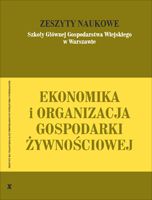Main Article Content
Article Details
BIEC (Bureau for Investments and Economic Cycles): Podstawowe pojęcia, tryb dostępu [http://www.biec.org/main.php?display=pojecia], 10.04.2007.
BURDA M., WYPŁOSZ CH., 2000: Makroekonomia, Podręcznik europejski, Polskie Wydawnictwo Ekonomiczne, Warszawa 2000.
CHARI V.V., CHRISTIANO L.J., KEHOE P., 1994: Optimal Fiscal Policy in a Business Cycle Model, Journal of Political Economy 102(4): 617-52. (Crossref)
COTIS J.P., COPPEL J., 2005: Business Cycle Dynamics in OECD Countries: Evidence, Causes and Policy Implications, referat na konferencję organizowaną przez Reserve Bank of Australia pt. "The Changing Nature of The Business Cycle", Sydney, Australia, lipiec 11-12.
DUNSTAN A., HARGREAVES D., KARAGEDIKLI O., 2007: The impact of fiscal policy on the business cycle, Reserve Bank of New Zealand Bulletin 70(1): 5-18.
FATÁS A., MIHOV I., 2000: Fiscal policy and business cycles: an empirical investigation Moneday Credito 211.
GABISCH G., LORENZ H.W., 1989: Business Cycle Theory. A Survey of Methods and Concepts, Springer-Verlag, Heidelberg. (Crossref)
GAJDA J.B., 2004: Ekonometria, Wyd. C.H. Beck, Warszawa, 2004.
GALI J., 1994: Government size and macroeconomic stability, European Economic Review 38(1): 117-132. (Crossref)
GRZĘDA-LATOCHA R., 2005: Ekonometryczna analiza koniunktury gospodarczej w euro-systemie, Ekonomista 5: 621-643.
GWARTNEY J., LAWSON R., HOLCOMBE R., 1998: The Size and Functions of Government and Economic Growth, Joint Economic Committee Report, Congress of the United States, Washington D.C.
HICKS J.R., 1950: A Contribution to the Theory of the Trade Cycle, Oxford University Press, Oxford.
HODRICK R.J., PRESCOTT E.C., 1997: Postwar U.S. Business Cycles: An Empirical Investigation, Journal of Money, Credit and Banking 29(1): 1-16. (Crossref)
KAISER R., MARAVALL A., 1999: Estimation of the business cycle: A modified Hodrick-Prescott filter, Spanish Economic Review 1: 175-206. (Crossref)
KING R. G., REBELO S., 1993: Low Frequency Filtering and Real Business-Cycles, Journal of Economic Dynamics and Control 17: 207-31. (Crossref)
KOT A., 2003: Restrykcyjność monetarna, fiskalna oraz policy mix w Polsce, Czechach i na Węgrzech, Bank i Kredyt 7: 4-14.
KYDLAND F.E., PRESCOTT E.C., 1982: Time to Build and Aggregate Fluctuations, Econometrica 50(6): 1345-1370. (Crossref)
LONG JR J.B., PLOSSER C.I., 1983: Real business cycles, Journal of Political Economy 91(1): 39-69. (Crossref)
MACKIEWICZ M., 2006: Reakcje polityki fiskalnej na wahania koniunkturalne - przyczyny zróżnicowania, Bank i Kredyt 10/2006: 3-16.
MADDALA G.S., 2006: Ekonometria, Wydawnictwo Naukowe PWN, Warszawa.
MC MORROW K., ROEGER W., 2001: Potential Output: Measurement Methods, "New" Economy Influences and Scenarios for 2001-2010 - A Comparison of the EU-15 and the US, Economic Papers 152, Komisja Europejska, Bruksela.
MCGRATTAN E.R., 2006: Real Business Cycle, Federal Reserve Bank of Minneapolis, Research Department Staff Report 370. (Crossref)
MYRDAL K.G., 1939: Fiscal Policy in the Business Cycle, The American Economic Review 29(1): 183-193.
NELSON C.R., PLOSSER C.I., 1982: Trends and random walks in macroeconomic time series: some evidence and implications. Journal of Monetary Economics 10: 139-162. (Crossref)
O wychodzeniu z recesji rozmawiają prof. Ryszard Rapacki i red. Witold Gadomski, Polskie Radio - Gospodarka, 12.03.2002, tryb dostępu: [http://www.polskieradio.pl/gospodarka/biznes.aspx?iID=17].
PRESCOTT E.C., 1986: Theory Ahead of Business Cycle Measurement, Federal Reserve Bank of Minneapolis Quarterly Review 10: 9-22. (Crossref)
RAPACKI R., 2005: Trzy mity o nierównościach, Rzeczpospolita 1270 (19.11.2005).
ROBERTSON D.H., 1915: A study of industrial fluctuations, P.S. King and Son, Londyn.
SAMUELSON P.A., 1939: Interactions between the Multiplier Analysis and the Principle of Acceleration, The Review of Economics and Statistics 21(2): 75-78. (Crossref)
SAMUELSON P.A., NORDHAUS W.D., 1995: Ekonomia 1, Wydawnictwo Naukowe PWN, Warszawa.
SCHUMPETER A., 1927: The Explanation of the Business Cycle, Economica 7: 286-311. (Crossref)
SCHUMPETER A., 1939: Business Cycles, McGraw-Hill, Nowy Jork - Londyn.
SNOWDON B., VANE H., WYNARCZYK P., 1998: Współczesne nurty teorii makroekonomii, Wydawnictwo Naukowe PWN, Warszawa.
SOLOW R. 1956: A Contribution to the Theory of Economic Growth, Quarterly Journal of Economics 70: 65-94. (Crossref)
Statistical Data Warehouse Europejskiego Banku Centralnego, tryb dostępu [http://sdw.ecb.int/], 08.04.2007.
STIGLITZ J.E., 2004: Ekonomia sektora publicznego, Wydawnictwo Naukowe PWN, Warszawa.
VERBEEK M., 2006: A Guide to Modern Econometrics, Wydawnictwo Wiley, Chichester.
WITKOWSKA D., 2006: Podstawy ekonometrii i teorii prognozowania, Oficyna Ekonomiczna, Kraków.
Downloads
- Aldona Zawojska, Tomasz Siudek, Financial and Non-financial Forms of Environment Protection Supporting , Zeszyty Naukowe SGGW - Ekonomika i Organizacja Gospodarki Żywnościowej: No. 38 (2000)
- Tomasz Siudek, Katarzyna Drabarczyk, Aldona Zawojska, Social development across counties of Mazovia region: quantification and assessment , Zeszyty Naukowe SGGW - Ekonomika i Organizacja Gospodarki Żywnościowej: No. 123 (2018)
- Aldona Zawojska, Beata Horbowiec, Price risk in agri-food market: sources, effects and managing methods , Zeszyty Naukowe SGGW - Ekonomika i Organizacja Gospodarki Żywnościowej: No. 115 (2016)
- Aldona Zawojska, Effects of Single European Currency on the Development of Agro-food Sector , Zeszyty Naukowe SGGW - Ekonomika i Organizacja Gospodarki Żywnościowej: No. 40 (2000)
- Aldona Zawojska, Liberalism, Neoliberalism, Economic and Political Freedom and Country’s Economic Development , Zeszyty Naukowe SGGW - Ekonomika i Organizacja Gospodarki Żywnościowej: No. 58 (2006)
- Aldona Zawojska, Speculation as a form of economic activity, moral and ethical issues , Zeszyty Naukowe SGGW - Ekonomika i Organizacja Gospodarki Żywnościowej: No. 83 (2010)
- Aldona Zawojska, CONDITIONS AND CHANNELS OF AGRICULTURE FINANCING IN POLAND , Zeszyty Naukowe SGGW - Ekonomika i Organizacja Gospodarki Żywnościowej: No. 65 (2008)
- Aldona Zawojska, Alina Daniłowska, Proceedings from the Participation in the V Congress of the Association of Agricultural and Agribusiness Economists "Agribusiness in the Countries of Central and Eastern Europe in a View of Integration with the European Union" , Zeszyty Naukowe SGGW - Ekonomika i Organizacja Gospodarki Żywnościowej: No. 36 (1999)
- Aldona Zawojska, Understanding Corruption - Economic Perspectives on Causes and Consequences of the Corruption , Zeszyty Naukowe SGGW - Ekonomika i Organizacja Gospodarki Żywnościowej: No. 51 (2003)
- Aldona Zawojska, Euro Zone versus new Member States of the European Union - Economic Divergence or Convergence? , Zeszyty Naukowe SGGW - Ekonomika i Organizacja Gospodarki Żywnościowej: No. 53 (2004)





